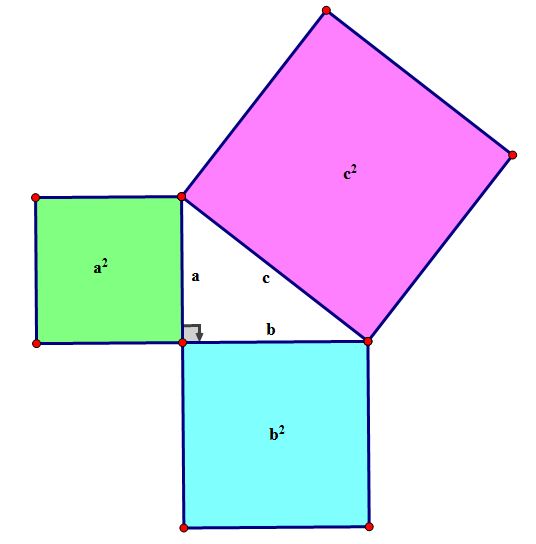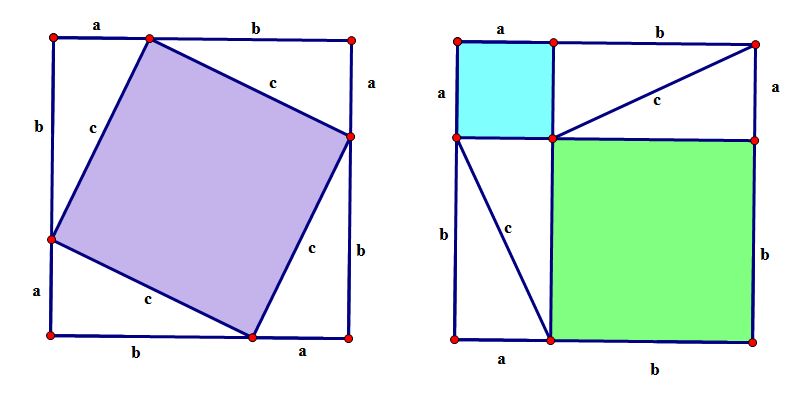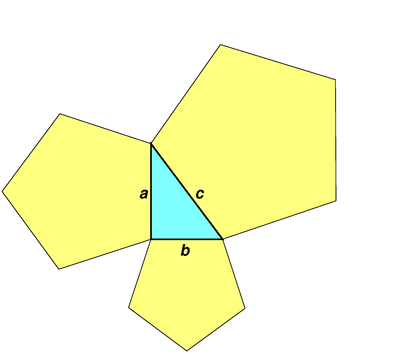
Pythagorean Theorem
by: Maggie Hendricks
Arguably one of the most famous mathematical concepts, the Pythagorean Theorem and all of its many related components provide endless activities and problems for students and teachers of mathematics to explore and discover. Named after its founder Pythagoras, the theorem states that for any right triangle with side lengths a, b, and c it is true that . Graphically this relationship can be seen by constructing squares off of the three side lengths of a right triangle, as shown below.
. Graphically this relationship can be seen by constructing squares off of the three side lengths of a right triangle, as shown below.

From the picture above, we can see that the Pythagorean Theorem tells us that the areas of the squares built off the legs of a right triangle sum to equal the area of the square built off the hypotenuse of the right triangle. There are various ways to go about proving the Pythagorean Theorem, and one such way involves using the graphic we just looked at. See the figure below to begin thinking through this first proof:

In both of the squares, we see four right triangles with side lengths a, b, and c. We also know that the squares are congruent, since they both have side lengths a+b. In the square on the left, we see a tilted square with side lengths c and area c^2. In the square on the left, we see two squares—one with side lengths a and area a^2 and the other with side lengths b and area b^2. If we wanted to find the area of the two largest squares that we started with, we would multiply the side length (a+b) by itself, and the result would be . We could also represent the area of the square on the left as the sum of the areas of the four triangles plus the square with side length c. This result would be
. We could also represent the area of the square on the left as the sum of the areas of the four triangles plus the square with side length c. This result would be  . Similarly, we could represent the area of the square on the right as the sum of the areas of the four triangles plus the area of the two squares with side lengths a and b. The result would be
. Similarly, we could represent the area of the square on the right as the sum of the areas of the four triangles plus the area of the two squares with side lengths a and b. The result would be . Since we already noted that the two squares are congruent, we can set all three area representations equal to one another as shown below:
. Since we already noted that the two squares are congruent, we can set all three area representations equal to one another as shown below:

Taking out the common terms, we are left with the theorem as desired, thus ending our proof.
In addition to building squares off the sides of the legs of a right triangle that will hold the relationship shown above, it should be noted that any type of similar shapes could be built off of the side lengths of a right triangle and the relationship between the three areas would still hold; that is, if we built pentagons off the sides of a right triangle, the sum of the areas of the two smaller pentagons would be equal to the area of the largest pentagon. See the figure below for a visual of this concept.

Another particularly interesting concept related to the Pythagorean Theorem is the set of numbers referred to as Pythagorean Triples. Pythagorean Triples are any three integer values (a, b, and c) which satisfy the Pythagorean Theorem ( ). One of the most basic examples of a Pythagorean Triple is the set 3, 4, and 5. This is also an example of a Triple that is referred to as being “primitive” because its least common denominator is 1.
). One of the most basic examples of a Pythagorean Triple is the set 3, 4, and 5. This is also an example of a Triple that is referred to as being “primitive” because its least common denominator is 1.
There are a wide variety of problems and explorations that can arise involving Pythagorean Triples. One such problem is the one described below:
If m and n are integers and m>n, show that

will generate a Pythagorean Triple for each choice of m and n.
To solve this problem, let’s substitute these new representations for a, b, and c into the Pythagorean Theorem and do a little algebraic manipulation:

The result shown above tells us that our equation has infinitely many solutions; that is, for any m and n we choose, the equation will hold true. Since we are restricting m and n to be integers here, we know that their resulting a, b, and c will also be integers.
For an Excel spreadsheet showing some generated Pythagorean Triples using m and n, click here.
The explorations and concepts discussed here in no way exhaust all of the possibilities related to the Pythagorean Theorem. They are merely meant to be an introduction to some of the fundamental ideas related to the theorem and its uses.
To return to Maggie's homepage, click here.


. Graphically this relationship can be seen by constructing squares off of the three side lengths of a right triangle, as shown below.
. We could also represent the area of the square on the left as the sum of the areas of the four triangles plus the square with side length c. This result would be
. Similarly, we could represent the area of the square on the right as the sum of the areas of the four triangles plus the area of the two squares with side lengths a and b. The result would be
. Since we already noted that the two squares are congruent, we can set all three area representations equal to one another as shown below:
). One of the most basic examples of a Pythagorean Triple is the set 3, 4, and 5. This is also an example of a Triple that is referred to as being “primitive” because its least common denominator is 1.